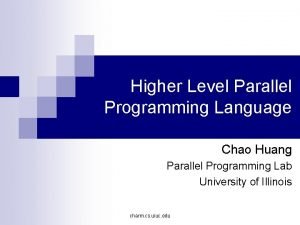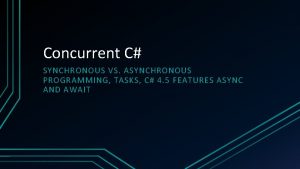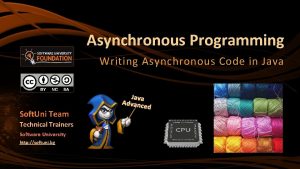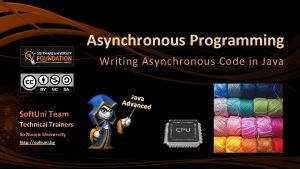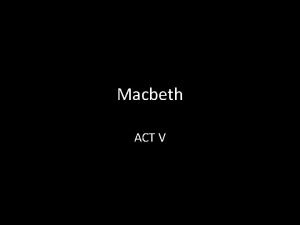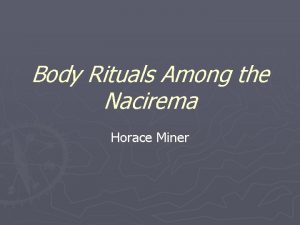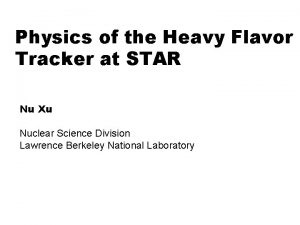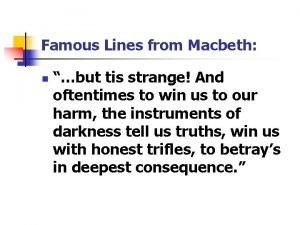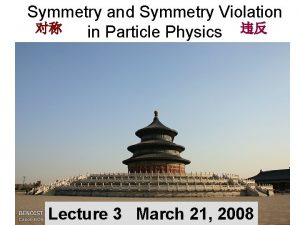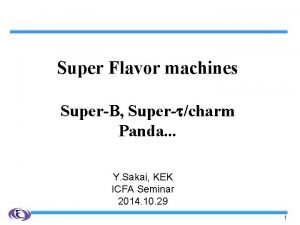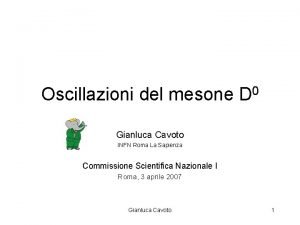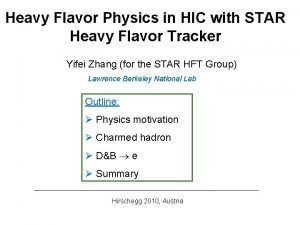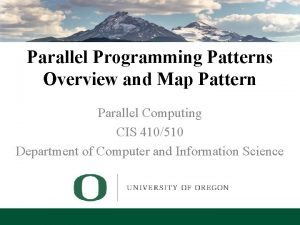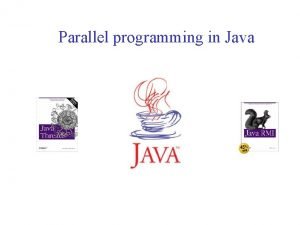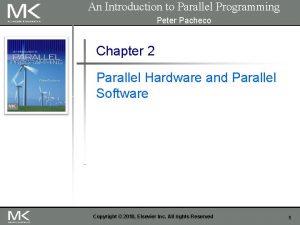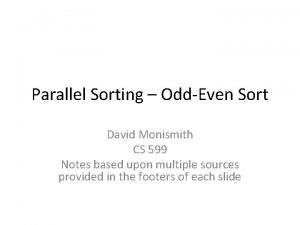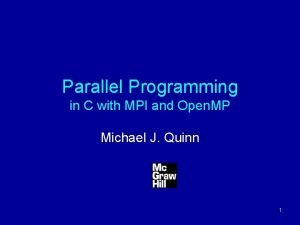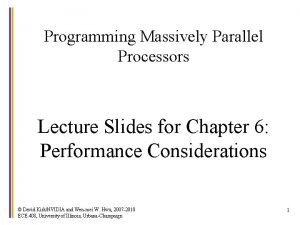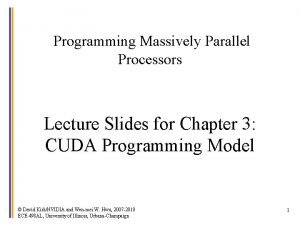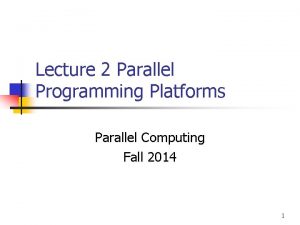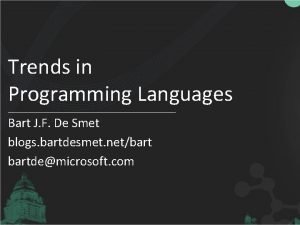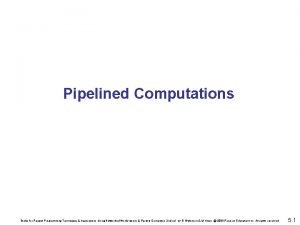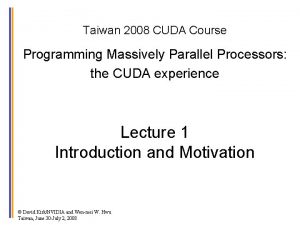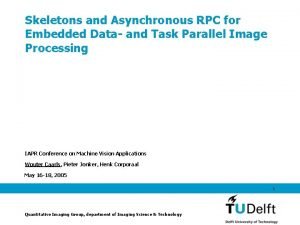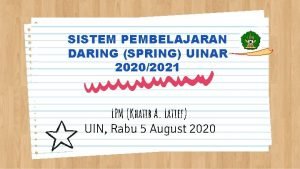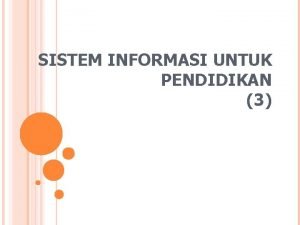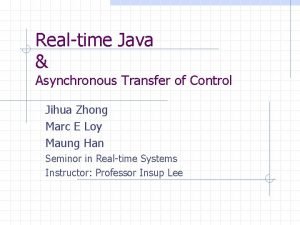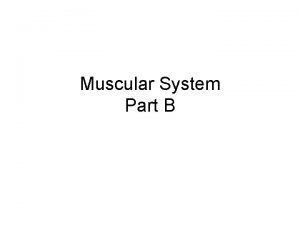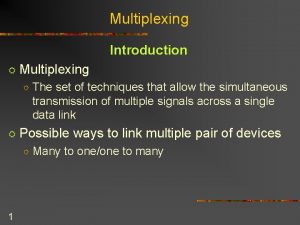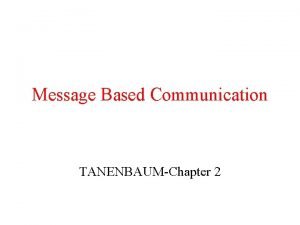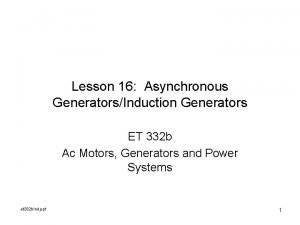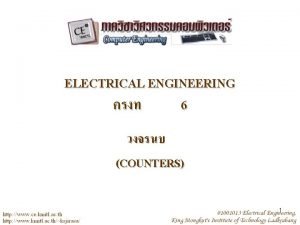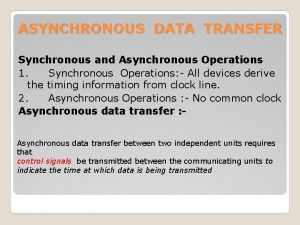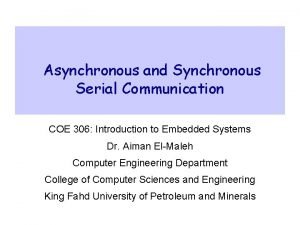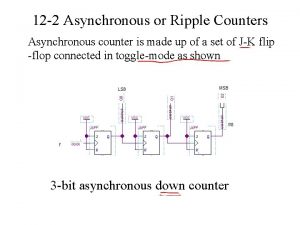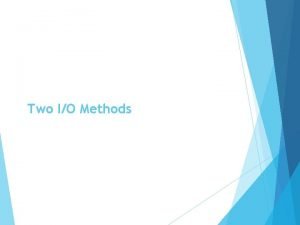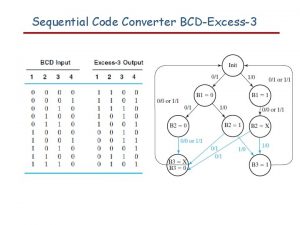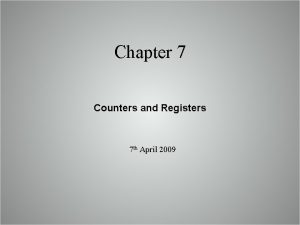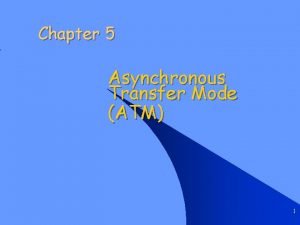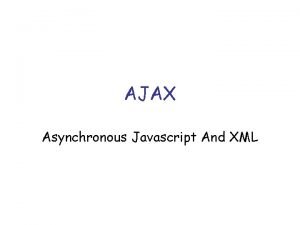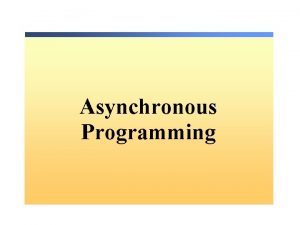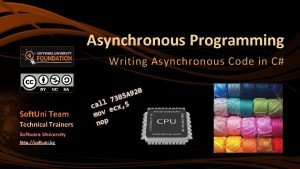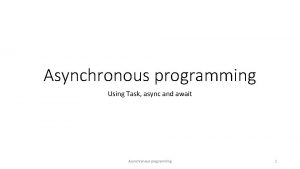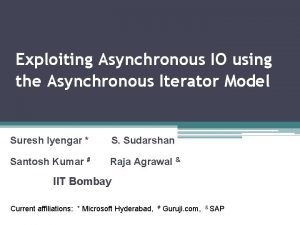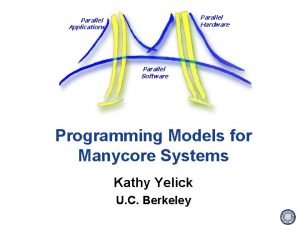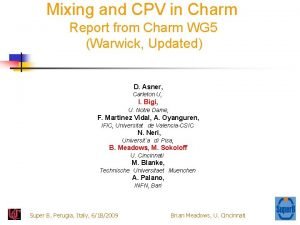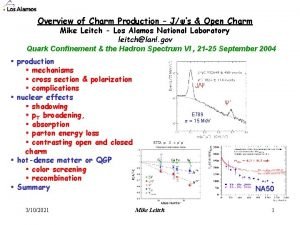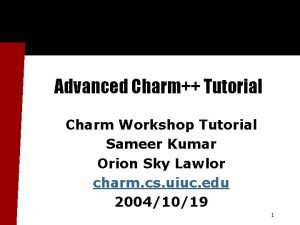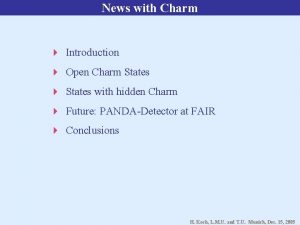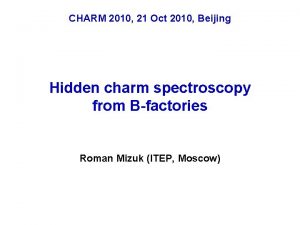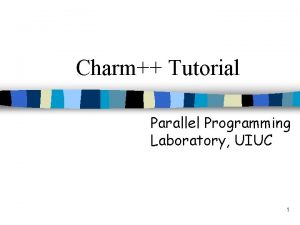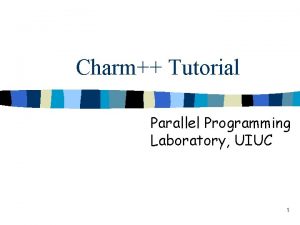Charm An Asynchronous Parallel Programming Model with an































































- Slides: 63

Charm++: An Asynchronous Parallel Programming Model with an Intelligent Adaptive Runtime System Laxmikant (Sanjay) Kale http: //charm. cs. illinois. edu Parallel Programming Laboratory Department of Computer Science University of Illinois at Urbana Champaign

Observations: Exascale applications • Development of new models must be driven by the needs of exascale applications – – – Multi-resolution Multi-module (multi-physics) Dynamic/adaptive: to handle application variation Adapt to a volatile computational environment Exploit heterogeneous architecture Deal with thermal and energy considerations • So? Consequences: – Must support automated resource management – Must support interoperability and parallel composition 10/29/2021 cs 598 LVK 2

Decomposition Challenges • Current method is to decompose to processors – But this has many problems – deciding which processor does what work in detail is difficult at large scale • Decomposition should be independent of number of processors – My group’s design principle since early 1990’s • in Charm++ and AMPI 10/29/2021 cs 598 LVK 3

Processors vs. “WUDU”s • Eliminate “processor” from programmer’s vocabulary – Well, almost • Decomposition into: – – Work-Units and Data Units (WUDUs) Work-units: code, one or more data units Data-units: sections of arrays, meshes, … Amalgams: • Objects with associated work-units, • Threads with own stack and heap • Who does decomposition? – Programmer, compiler, or both 10/29/2021 cs 598 LVK 4

Different kinds of units • Migration units: – objects, migratable threads (i. e. , “processes”), data sections • DEBs: units of scheduling – Dependent Execution Block – Begins execution after one or more (potentially) remote dependence is satisfied • SEBs: units of analysis – Sequential Execution Blocks – A DEB is partitioned into one or more SEBs – Has a “reasonably large” granularity, and uniformity in code structure – Loop nests, functions, … 10/29/2021 cs 598 LVK 5

Migratable objects programming model • Names for this model: – – 10/29/2021 Overdecompostion approach Object-based overdecomposition Processor virtualization Migratable-objects programming model cs 598 LVK 6

Adaptive Runtime Systems • Decomposing program into a large number of WUDUs empowers the RTS, which can: – Migrate WUDUs at will – Schedule DEBS at will – Instrument computation and communication at the level of these logical units • WUDU x communicates y bytes to WUDU z every iteration • SEB A has a high cache miss ratio – Maintain historical data to track changes in application behavior • Historical => previous iterations • E. g. , to trigger load balancing 10/29/2021 cs 598 LVK 7

Over-decomposition and message-driven execution Scalable Tools Emulation for Perf Prediction Migratability Automatic overlap, pefetch, compositionality Fault Tolerance Introspective and adaptive runtime system Dynamic load balancing (topology -aware, scalable) Temperature/power considerations Higher-level abstractions Languages and Frameworks Control Points 10/29/2021 cs 598 LVK 8

Utility for Multi-cores, Many-cores, Accelerators: • Objects connote and promote locality • Message-driven execution – A strong principle of prediction for data and code use – Much stronger than principle of locality • Can use to scale memory wall: • Prefetching of needed data: – into scratch pad memories, for example 10/29/2021 Scheduler Message Q cs 598 LVK 9

Impact on communication • Current use of communication network: – Compute-communicate cycles in typical MPI apps – So, the network is used for a fraction of time, – and is on the critical path • So, current communication networks are over -engineered for by necessity • With overdecomposition – Communication is spread over an iteration – Also, adaptive overlap of communication and computation 10/29/2021 cs 598 LVK 10

Compositionality • It is important to support parallel composition – For multi-module, multi-physics, multi-paradigm applications… • What I mean by parallel composition – – B || C where B, C are independently developed modules B is parallel module by itself, and so is C Programmers who wrote B were unaware of C No dependency between B and C • This is not supported well by MPI – Developers support it by breaking abstraction boundaries • E. g. , wildcard recvs in module A to process messages for module B – Nor by Open. MP implementations: 10/29/2021 cs 598 LVK 11

Without message-driven execution (and virtualization), you get either: Space-division B C Time 10/29/2021 cs 598 LVK 12

OR: Sequentialization B C Time 10/29/2021 cs 598 LVK 13

Parallel Composition: A 1; (B || C ); A 2 Recall: Different modules, written in different languages/paradigms, can overlap in time and on processors, without programmer having to worry about this explicitly 10/29/2021 cs 598 LVK 14

Decomposition Independent of num. Cores • Rocket simulation example under traditional MPI • Solid Fluid 1 2 . . . Solid Fluid P With migratable-objects: Solid 1 Fluid 1 Solid 2 Fluid 2 Solid 3 . . . Solidn Fluidm – Benefit: load balance, communication optimizations, modularity 10/29/2021 cs 598 LVK 15

Charm++ and CSE Applications Well-known Biophysics molecular simulations App Nano-Materials. . Gordon Bell Award, 2002 Synergy Enabling CS technology of parallel objects and intelligent runtime systems has led to several CSE collaborative applications ISAM Computational Astronomy 10/29/2021 Charm. Simdemics cs 598 LVK Stochastic Optimization 16

Object Based Over-decomposition: Charm++ • Multiple “indexed collections” of C++ objects • Indices can be multi-dimensional and/or sparse • Programmer expresses communication between objects – with no reference to processors System implementation User View 10/29/2021 cs 598 LVK 17

Parallelization Using Charm++ The computation is decomposed into “natural” objects of the application, which are assigned to processors by Charm++ RTS Bhatele, A. , Kumar, S. , Mei, C. , Phillips, J. C. , Zheng, G. & Kale, L. V. 2008 Overcoming Scaling Challenges in Biomolecular Simulations across Multiple Platforms. In Proceedings of IEEE International Parallel and Distributed Processing Symposium, Miami, FL, USA, April 2008. 10/29/2021 cs 598 LVK 18

Apo-A 1, on Blue. Gene/L, 1024 procs Charm++’s “Projections” Analysis tool green: communication Time intervals on x axis, activity added across processors on Y axis Blue/Purple: electrostatics Red: integration Orange: PME turquoise: angle/dihedral 10/29/2021 Time cs 598 LVK 19

Performance on Intrepid (BG/P) 65536 Ideal PME 16384 cutoff w/ barrier cutoff w/o barrier Speedup 32768 PME: 162. 6 ms/step (~1. 1 ns/day) 8192 4096 2048 10/29/2021 4096 8192 16384 Number of Cores cs 598 LVK 32768 65536 20

Timestep (ms/step) SMP Performance on Titan(Dev) 13 ms/ step Number of cores 10/29/2021 21 cs 598 LVK 9 ms/step

Object Based Over-decomposition: AMPI • Each MPI process is implemented as a user-level thread • Threads are light-weight and migratable! – <1 microsecond context switch time, potentially >100 k threads per core • Each thread is embedded in a charm++ object (chare) MPI processes Virtual Processors (user-level migratable threads) Real Processors 10/29/2021 cs 598 LVK 22

A quick Example: Weather Forecasting in BRAMS • Brams: Brazillian weather code (based on RAMS) • AMPI version (Eduardo Rodrigues, with Mendes and J. Panetta) 10/29/2021 cs 598 LVK 23

10/29/2021 cs 598 LVK 24

Baseline: 64 objects on 64 processors 10/29/2021 cs 598 LVK 25

Over-decomposition: 1024 objects on 64 processors: Benefits from communication/computation overlap 10/29/2021 cs 598 LVK 26

With Load Balancing: 1024 objects on 64 processors 10/29/2021 No overdecomp (64 threads) 4988 sec Overdecomp into 1024 threads 3713 sec Load balancing (1024 threads) 3367 sec cs 598 LVK 27

Principle of Persistence • Once the computation is expressed in terms of its natural (migratable) objects • Computational loads and communication patterns tend to persist, even in dynamic computations • So, recent past is a good predictor of near future In spite of increase in irregularity and adaptivity, this principle still applies at exascale, and is our main friend. 10/29/2021 cs 598 LVK 28

Measurement-based Load Balancing Regular Timesteps Instrumented Timesteps 10/29/2021 Detailed, aggressive Load Balancing Refinement Load Balancing cs 598 LVK 29

Cha. NGa: Parallel Gravity • Collaborative project (NSF) Evolution of Universe and Galaxy Formation – with Tom Quinn, Univ. of Washington • Gravity, gas dynamics • Barnes-Hut tree codes – Oct tree is natural decomp – Geometry has better aspect ratios, so you “open” up fewer nodes – But is not used because it leads to bad load balance – Assumption: one-to-one map between sub-trees and PEs – Binary trees are considered better load balanced 10/29/2021 cs 598 LVK With Charm++: Use Oct-Tree, and let Charm++ map subtrees to processors 30

Control flow 10/29/2021 cs 598 LVK 31

CPU Performance 10/29/2021 cs 598 LVK 32

GPU Performance 10/29/2021 cs 598 LVK 33

Load Balancing for Large Machines: I • Centralized balancers achieve best balance – Collect object-communication graph on one processor – But won’t scale beyond tens of thousands of nodes • Fully distributed load balancers – Avoid bottleneck but… Achieve poor load balance – Not adequately agile • Hierarchical load balancers – Careful control of what information goes up and down the hierarchy can lead to fast, high-quality balancers • Need for a universal balancer that works for all applications 10/29/2021 cs 598 LVK 34

Load Balancing for Large Machines: II • Interconnection topology starts to matter again – Was hidden due to wormhole routing etc. – Latency variation is still small – But bandwidth occupancy is a problem • Topology aware load balancers – Some general heuristic have shown good performance • But may require too much compute power – Also, special-purpose heuristic work fine when applicable – Still, many open challenges 10/29/2021 cs 598 LVK 35

Open. Atom Car-Parinello Molecular Dynamics NSF ITR 2001 -2007, IBM, DOE Molecular Clusters : Nanowires: G. Martyna (IBM) M. Tuckerman (NYU) L. Kale (UIUC) J. Dongarra Semiconductor Surfaces: 3 D-Solids/Liquids: Using Charm++ virtualization, we can efficiently scale small (32 molecule) systems to thousands of processors 10/29/2021 cs 598 LVK 36

Decomposition and Computation Flow 10/29/2021 cs 598 LVK 37

Topology Aware Mapping of Objects 10/29/2021 cs 598 LVK 38

Improvements by topological aware mapping of computation to processors Punchline: Overdecomposition into Migratable Objects created the degree of freedom needed for flexible mapping The simulation of the right panel, maps computational work to processors taking the network connectivity into account while the left panel simulation does not. The “black’’ or idle time processors spent waiting for computational work to arrive on processors is significantly reduced at left. (256 waters, 70 R, on BG/L 4096 cores) 10/29/2021 cs 598 LVK 39

Open. Atom Performance Sampler Ongoing work on: K-points 10/29/2021 cs 598 LVK 40

Saving Cooling Energy • Some cores/chips might get too hot – We want to avoid • Running everyone at lower speed, • Conservative (expensive) cooling • Reduce frequency (DVFS) of the hot cores? – Works fine for sequential computing – In parallel: • There are dependences/barriers • Slowing one core down by 40% slows the whole computation by 40%! – Big loss when the #processors is large Migratable Objects to the rescue! 10/29/2021 cs 598 LVK 41

Temperature-aware Load Balancing • Reduce frequency if temperature is high – Independently for each core or chip • Migrate objects away from the slowed-down processors – Balance load using an existing strategy – Strategies take speed of processors into account • Recently implemented in experimental version – SC 2011 paper 10/29/2021 cs 598 LVK 42

Benefits of Temperature Aware LB Projections timeline without (top) and with (bottom) temperature aware LB Zoomed projection timeline for two iterations without temperature aware LB 10/29/2021 cs 598 LVK 44

Benefits of Temperature Aware LB 10/29/2021 cs 598 LVK 45

Other Power-related Optimizations • Other optimizations are in progress: – Staying within given energy budget, or power budget • Selectively change frequencies so as to minimize impact on finish time – Reducing power consumed with low impact on finish time • Identify code segments (methods) with high miss-rates – Using measurements (principle of persistence) • Reduce frequencies for those, • and balance load with that assumption – Use critical paths analysis: • Slow down methods not on critical paths • Aggressive: migrate critical-path objects to faster cores 10/29/2021 cs 598 LVK 46

Fault Tolerance in Charm++/AMPI • Four Approaches: – – Disk-based checkpoint/restart In-memory double checkpoint/restart Proactive object migration Message-logging: scalable fault tolerance • Common Features: – Easy checkpoint: • migrate-to-disk leverages object-migration capabilities – Based on dynamic runtime capabilities – Can be used in concert with load-balancing schemes 10/29/2021 cs 598 LVK 47

In-memory checkpointing • Is practical for many apps – Relatively small footprint at checkpoint time • Very fast times… • Demonstration challenge: – Works fine for clusters – For MPI-based implementations running at centers: • Scheduler does not allow job to continue on failure • Communication layers not fault tolerant – Fault injection: die. Now(), – Spare processors 10/29/2021 cs 598 LVK 48

10/29/2021 cs 598 LVK 49

10/29/2021 cs 598 LVK 50

10/29/2021 cs 598 LVK 51

Scalable Fault tolerance • Faults will be common at exascale – Failstop, and soft failures are both important • Checkpoint-restart may not scale – Requires all nodes to roll back even when just one fails • Inefficient: computation and power – As MTBF goes lower, it becomes infeasible 10/29/2021 cs 598 LVK 52

Message-Logging • Basic Idea: – Messages are stored by sender during execution – Periodic checkpoints still maintained – After a crash, reprocess “resent” messages to regain state • Does it help at exascale? – Not really, or only a bit: Same time for recovery! • With virtualization, – work in one processor is divided across multiple virtual processors; thus, restart can be parallelized – Virtualization helps fault-free case as well 10/29/2021 cs 598 LVK 53

Message-Logging (cont. ) • Fast Parallel restart performance: – Test: 7 -point 3 D-stencil in MPI, P=32, 2 ≤ VP ≤ 16 – Checkpoint taken every 30 s, failure inserted at t=27 s 10/29/2021 cs 598 LVK 54 54

Power consumption is continuous Normal Checkpoint-Resart method Progress is slowed down with failures Time 10/29/2021 cs 598 LVK 55

Power consumption is lower during recovery Message logging + Object-based virtualization Progress is faster with failures 10/29/2021 cs 598 LVK 56

HPC Challenge Competition • Conducted at Supercomputing • 2 parts: – Class I: machine performance – Class II: programming model productivity • Has been typically split in two sub-awards – We implemented in Charm++ • • LU decomposition Random. Access Lean. MD Barnes-Hut • Main competitors this year: – Chapel (Cray), CAF (Rice), and Charm++ (UIUC) 10/29/2021 cs 598 LVK 57

Strong Scaling on Hopper for Lean. MD Gemini Interconnect, much less noisy 10/29/2021 cs 598 LVK 58

Charm. LU: productivity and performance • 1650 lines of source • 67% of peak on Jaguar 10/29/2021 cs 598 LVK 59

Barnes-Hut High Density Variation with a Plummer distribution of particles Won HPCC Class II (performance) 10/29/2021 cs 598 LVK 60

Charm++ interoperates with MPI Charm++ Control 10/29/2021 cs 598 LVK 61

A View of an Interoperable Future X 10 10/29/2021 cs 598 LVK 62

Interoperability allows faster evolution of programming models Evolution doesn’t lead to a single winner species, but to a stable and effective ecosystem. Similarly, we will get to a collection of viable programming models that co-exists well together. 10/29/2021 cs 598 LVK 63

Summary • Do away with the notion of processors – Adaptive Runtimes, enabled by migratable-objects programming model • Are necessary at extreme scale • Need to become more intelligent and introspective • Help manage accelerators, balance load, tolerate faults, • Interoperability, concurrent composition become even more important – Supported by Migratable Objects and message-driven execution • Charm++ is production-quality and ready for your application! – You can interoperate with Charm++, AMPI, MPI and Open. MP modules • New programming models and frameworks – Create an ecosystem/toolbox of programming paradigms rather than one “super” language More Info: http: //charm. cs. illinois. edu/ 10/29/2021 cs 598 LVK 64
 Charm programming language
Charm programming language Synchronous vs asynchronous programming
Synchronous vs asynchronous programming Java asynchronous programming
Java asynchronous programming Asynchronous programming in java
Asynchronous programming in java Charm and grace
Charm and grace Let every soldier hew him down a bough
Let every soldier hew him down a bough Special charm and appeal 8
Special charm and appeal 8 Language
Language O the wonderful cross
O the wonderful cross Shrines nacirema
Shrines nacirema Tentaizu backtracking
Tentaizu backtracking Charm mesom
Charm mesom Naught's had all's spent
Naught's had all's spent It has its charm
It has its charm Ffa charm
Ffa charm A charm quark has a charge of approximately
A charm quark has a charge of approximately Virtual production
Virtual production Charm
Charm Mesone charm
Mesone charm Charm
Charm Heavy flavor physics
Heavy flavor physics Supertunia mulberry charm
Supertunia mulberry charm Perbedaan linear programming dan integer programming
Perbedaan linear programming dan integer programming Greedy vs dynamic
Greedy vs dynamic System programming vs application programming
System programming vs application programming Linear vs integer programming
Linear vs integer programming Definisi integer
Definisi integer Programming massively parallel processors
Programming massively parallel processors Parallel programming patterns
Parallel programming patterns Java parallel programming
Java parallel programming An introduction to parallel programming peter pacheco
An introduction to parallel programming peter pacheco Bubble sort mpi
Bubble sort mpi Mpi parallel programming in c
Mpi parallel programming in c Programming massively parallel processors
Programming massively parallel processors Programming massively parallel processors
Programming massively parallel processors Parallel programming platforms
Parallel programming platforms F# parallel programming
F# parallel programming Parallel programming
Parallel programming Programming massively parallel processors, kirk et al.
Programming massively parallel processors, kirk et al. Pleonastic sound
Pleonastic sound Asynchronous rpc
Asynchronous rpc Pembelajaran synchronous dan asynchronous
Pembelajaran synchronous dan asynchronous Pembelajaran synchronous dan asynchronous
Pembelajaran synchronous dan asynchronous Asynchronous transfer of control
Asynchronous transfer of control Eccentric movement
Eccentric movement Synchronous and asynchronous tdm
Synchronous and asynchronous tdm Transient communication examples
Transient communication examples Asynchronous generator python
Asynchronous generator python Site:slidetodoc.com
Site:slidetodoc.com Rangkaian counter
Rangkaian counter Persistent and transient communication
Persistent and transient communication What is synchronous and asynchronous data transfer
What is synchronous and asynchronous data transfer Asynchronous data transfer in computer architecture
Asynchronous data transfer in computer architecture Counter in digital electronics
Counter in digital electronics What is synchronous and asynchronous data transfer
What is synchronous and asynchronous data transfer 4 bit asynchronous counter truth table
4 bit asynchronous counter truth table Advantages of asynchronous transfer mode
Advantages of asynchronous transfer mode Synchronous and asynchronous i/o
Synchronous and asynchronous i/o Register sistem digital
Register sistem digital Equivalent state
Equivalent state Asynchronous trigger sql server
Asynchronous trigger sql server Mod-60 counter circuit diagram
Mod-60 counter circuit diagram Asynchronous transfer mode architecture
Asynchronous transfer mode architecture Ajax asynchronous javascript and xml
Ajax asynchronous javascript and xml
